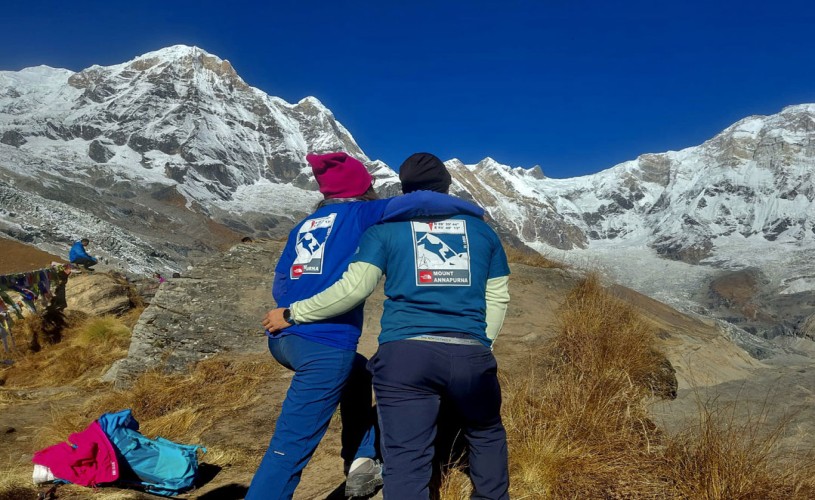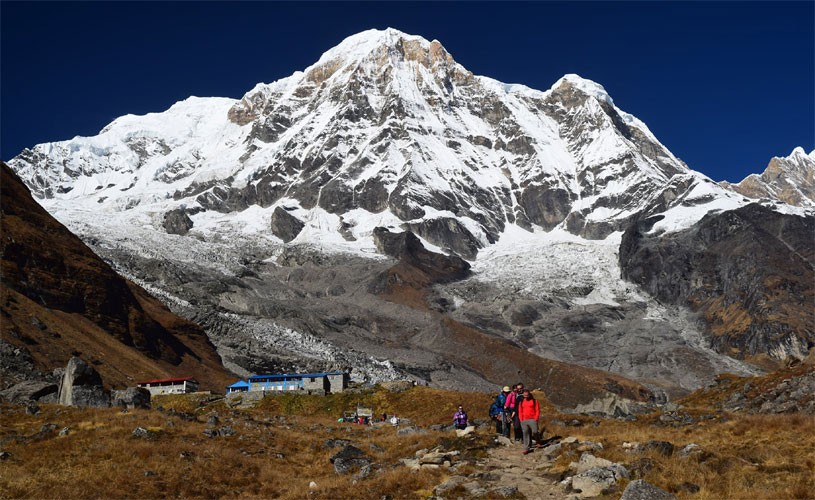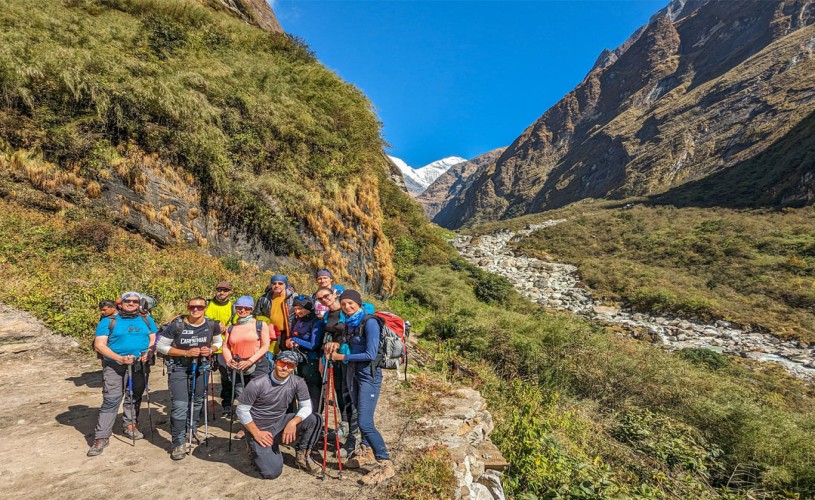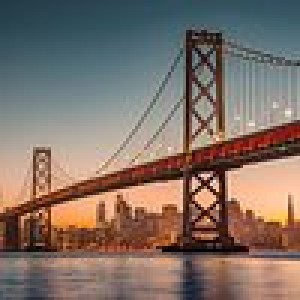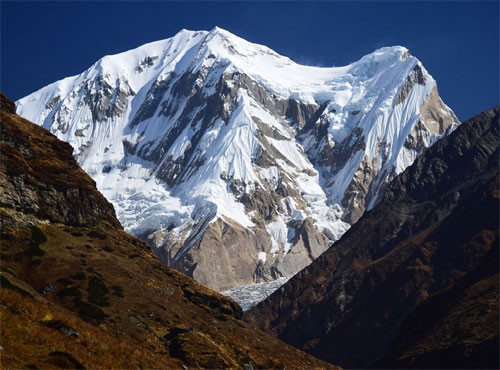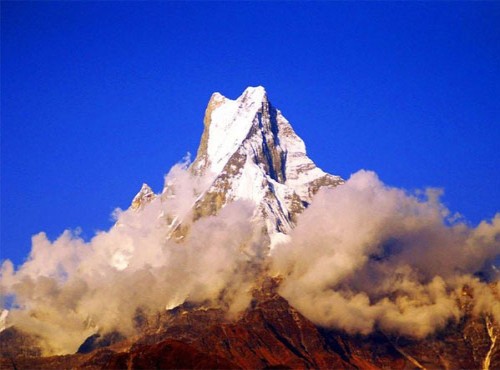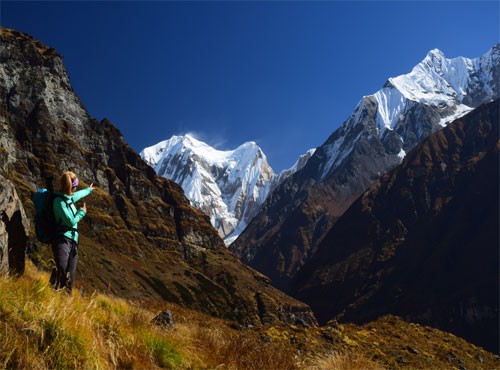Annapurna Base Camp Trek Highlights:
- Scenic Drive from Kathmandu and Pokhara
- A dense forest of oak trees, Rhododendron flowers
- Ethnic settlements like Ghorepani, Ghandruk
- Amazing viewpoint- Poon Hill (3210m) - Mt. Annapurna, Fishtail, Dhaulagiri
- A trail with a frequent switchback
- Magar and Gurung hospitality
- Rice and millet fields along the trail
- Witnissing Hiunchuli, Machapuchare (fishtail),and Gangapurna.
- Ghandruk is a typical Gurung village with an amazing view of Annapurna South.
- This trail runs through a forest rich in flora and fauna.
- Enjoying the therapeutic natural hot springs of Jhinu Danda just beside the river
12 Days Annapurna Base Camp Trek Cost 2025/2026 Price
Annapurna Base Camp Trek -12-Day Trek takes you to the amazing Annapurna region, surrounded by huge Himalayan walls at an altitude of 4130 meters. This itinerary is designed for those with a busy schedule who want to explore the beautiful landscapes of the Annapurna Himalayas and nearby areas, including Ghorepani village and Poon Hill (3210 meters). The trek involves walking for about 6-7 hours each day through rhododendron forests and charming ethnic villages. If you have moderate physical fitness, this trek is suitable for you. In addition to the natural beauty, you'll experience the rich culture of ethnic communities like the Gurung and Magar people, enjoying their incredible hospitality during the ABC Short Trek.
The 12-day Annapurna Base Camp Trek is a great choice for people who want to explore the best trekking in Nepal but have limited time. It's also called the Annapurna Sanctuary Trek. It takes place in the northwest part of Nepal within the Annapurna Conservation Area Project. This trek cuts out unnecessary detours and takes you directly to the beautiful landscapes and ethnic settlements of the Annapurna region. The highlight is reaching the magnificent Annapurna Base Camp at 4130 meters.
The journey to Annapurna Base Camp Trek begins with an exciting bus ride from Kathmandu to Pokhara. Then, you'll take a bus to Nayapul and head to Ulerri to start your trek in the foothills. There are different paths to choose from, and our ABC Treks usually take the route through Ghorepani Poon Hill, which is a popular choice among many trekkers. During the trek, you'll pass through interesting villages such as Hile, Tikhedhunga, Ulleri, and Ghorepani, where people from various ethnic backgrounds live.
During your journey to Annapurna Base Camp, you'll pass through places like Ulerri, Ghorepani, Poonhill, Tadapani, Chhomrong, Deurali, and MBC. After leaving the Modi River Valley, you'll reach a peaceful spot called Bamboo to spend the night. The next day, you'll leave the Annapurna Sanctuary and head to Jhinu Danda. At Jhinu Danda, there are natural hot springs to relax your muscles. From there, you'll walk to Siwai and then take a jeep to Pokhara. The 12-day trek ends when you fly back to Kathmandu.
The Annapurna Short Trek 12-Day is designed for time-constrained hikers who want a relaxing journey to the Annapurna camp. The itinerary includes Poon Hill and World Heritage Sites. The Annapurna Circular Trek 14 Days is a better option for guests who have more than two weeks.
When is the best time to do the Annapurna Base Camp Trek?
The best time to do the Annapurna Base Camp trek is in March, April, May (spring), September, October, and November (autumn/fall), and late Winter in February. But you can trek to the Annapurna Base Camp at any time of the year. Winter trekking may not be as popular as in spring or autumn, but it's still beautiful. In Winter, it can get cold at night and in the early mornings, with temperatures dropping below freezing. Despite the cold, there aren't many difficulties in trekking to Annapurna Base Camp during Winter.
How difficult is the Annapurna Base Camp Trek?
Annapurna Base Camp Trek is relatively easier than the Everest Base Camp Trek. It is because the hike to Annapurna base camp involves shorter trekking days, a maximum elevation of 4,130m/13.550 feet, and a minimum of days at higher elevations. Annapurna has a higher oxygen content in the air due to the lush forests at low altitudes. Annapurna Base Camp Trek begins at 800m/2.625" altitude, allowing for sufficient time to acclimatize. The fitness required for both treks is the same, even though the Annapurna Base Camp Trek may be easier. The trek does not require any technical skills or mountaineering and rock climbing expertise, as it is a long walk on the low elevations of the southern flank of the Annapurna Massif. It is only difficult because the trek lasts 9 days and includes lots of uphill and downhill walks. (11 days, including arrival and departure). If you have limited time, it is possible to complete the trek in 7 days by taking the shorter route.
Is it Safe to Do a 12-Day Annapurna Trek?
Yes, the 12-day Annapurna Base Camp (ABC) trek is considered safe and accessible. With a maximum altitude of 4,130 meters, it’s easier than higher-altitude treks like Everest Base Camp, making it ideal for travelers concerned about altitude sickness. Adventure Club Trek designed this itinerary for travelers of all ages and abilities, offering a flexible pace and ensuring your comfort throughout. We can also customize the trek to meet your preferences. Feel free to contact us via WhatsApp at +977 9851025658 to plan your Journey!
Meals on Annapurna Base Camp Trek
All meals — breakfast, lunch, and dinner — will be provided during the trek, and breakfast will only be provided in Kathmandu and Pokhara. We host welcome and farewell dinners for our guests. During the trek, we have breakfast and dinner at tea houses or lodges where we spend nights, while there will be lunch at tea houses on the way. You have the option to choose from Nepali, continental, Tibetan, and Indian cuisines. As we care for our guests, we ensure you get healthy food. We prioritize locally produced organic food and also provide you with seasonal fruits. During the climbing session, hygienic, freshly cooked food will be provided.
Note: If you are a vegetarian, let us know in advance so that we can make proper arrangements for food as per your wish during the trek
Accommodations on the Annapurna Base Camp Trek
You will be accommodated in a three-star standard hotel in Kathmandu, Pokhara, and the best available teahouses during the trek. All accommodations are on a twin-shared basis. A single supplement will be served on request and will cost an additional fee. Since you will be trekking in remote regions, the services in the teahouses/guesthouses will be basic. We will try our best to arrange rooms with attached washrooms; however, teahouses in some places do not have attached bathrooms.
Drinking Water on Annapurna Base Camp Trek
Adventure Club provides all the meals on the trek, but doesn't provide water. The best option is to treat the local water with chlorine/iodine tablets or a steripen. The tea houses will give you good quality free water; you can also get water along the trail, but you will need to treat it. If you are using the tablets, make sure they dissolve completely (about 30 mins). On most treks, you can buy mineral water along the trail. A liter of mineral water at lower-elevation tea houses costs around USD 1, but at higher elevations it may cost up to $4, so the cost can add up.
Electricity, WIFI, And Battery Recharge in the Annapurna Region
During the Annapurna base camp trek, electricity is available at all the teahouses where you will spend the night. You can recharge your phones, laptops, or iPads from micro-hydropower and solar panels by paying a nominal charge. Regarding Wi-Fi, there are no free hotspots along the trekking trail, so we do not encourage carrying your laptop. Every Teahouse offers paid Wi-Fi services hourly, but don't expect high-speed connectivity on the trekking trails.

